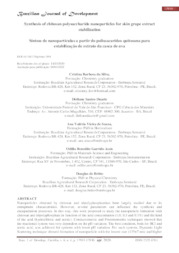Synthesis of chitosan polysaccharide nanoparticles for skin grape extract stabilization.
Synthesis of chitosan polysaccharide nanoparticles for skin grape extract stabilization.
Autoria: SILVA, C. B. da; DUARTE, D. S.; SOUZA, A. V. de; ASSIS, O. B. G. de; BRITTO, D. de
Resumo: Nanoparticles obtained by chitosan and tripolyphosphatehas been largely studied due to its entrapment characteristics. However, several parameters can influence the synthesis and encapsulationprocesses. In this way, this work proposed to study the nanoparticle formation with chitosan and tripolyphosphate in function of the acid concentration (1.0; 0.5 and0.1%) and the kind of the acid (hydrochloric and acetic). Conductometric and Potentiometric techniques showed that the reactional system was very dependent on the pH variation. The best condition, both for HCl and acetic acid, was achieved for systems with lower pH variation. For such systems, Dynamic Light Scattering technique showed formation of nanoparticle with the lowest size (135±7 nm) and higher stability (zeta potential near 30 mV). Also, by Scanning Electronic Microscopy, such systems exhibited good morphological aspect, with nanoparticles having spherical shape and lower level of agglomeration. The cryoprotection with sucrose solution before freeze-drying was fundamental to get samples with the improved re-suspension ability and preserved nanoparticle character. By UV-visible spectrophotometry, both HCl and acetic acid-based systems resulted in nanoparticles with good polyphenols encapsulation efficiency (~70%). The release profile was pH-dependent. In this way, the chitosan and tripolyphosphate ionic gelification need an accurate pH control both in the synthesis and in the encapsulation-release processes.
Ano de publicação: 2020
Tipo de publicação: Artigo de periódico
Unidade: Embrapa Semiárido
Palavras-chave: Casca de uva, Encapsulamento, Hidrogel, Nanopartículas, Polieletrólito, Polifenóis, Quitosana, Reticulação iônica, Uva
Observações
1 - Por padrão são exibidas publicações dos últimos 20 anos. Para encontrar publicações mais antigas, configure o filtro ano de publicação, colocando o ano a partir do qual você deseja encontrar publicações. O filtro está na coluna da esquerda na busca acima.
2 - Para ler algumas publicações da Embrapa (apenas as que estão em formato ePub), é necessário ter, no celular ou computador, um desses softwares gratuitos. Sistemas Android: Google Play Livros; IOS: iBooks; Windows e Linux: software Calibre.
Acesse outras publicações
Acesse a Base de Dados da Pesquisa Agropecuária (BDPA) para consultar o acervo completo das bibliotecas da Embrapa.

